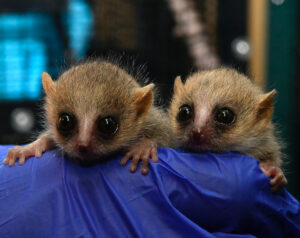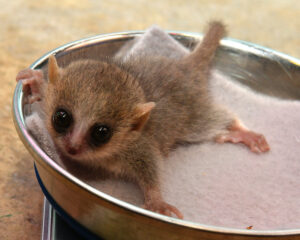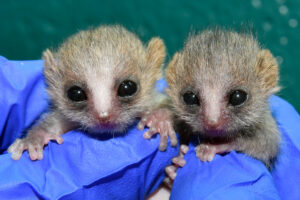It’s a Boy! Meet Baneberry

Baneberry, the first mouse lemur infant of the 2023 season, is weighed in an empty yogurt cup. Photo by David Haring.
When gray mouse lemur (Microcebus murinus) Indigo strolled out of her nest box for breakfast on June 26, 2023, she was not alone; held gingerly in her mouth was a male infant, the first of our 2023 mouse lemur breeding season. Because adult gray mouse lemurs only weigh between 1 1/2 and 3 ounces, their infants are born itty bitty—less than 1/10 of an ounce.

Baneberry’s full body, in comparison to the empty yogurt cup used by our vets for routine baby weighings. Photo by David Haring.
Mouse lemur breeding season is a little more frenetic than those of our other species. Gray mouse lemurs are normally solitary, so males and females have to be introduced for breeding. Competition is an integral part of mouse lemur courtship, so each female needs to be introduced to multiple males at once. Then, once successful breeding has occurred, females are only pregnant for about 60 days before giving birth. Twins are most common, but mouse lemur moms can also have singletons (like Baneberry) or triplets.
Here at the Duke Lemur Center, we name mouse lemur infants after plants, herbs, spices, and hot sauces. Baneberry shares his name with a toxic flowering plant that sports either bright red or waxy white berries, depending on the variety.
Meet Our Sweetest Girls, Marshmallow and Peppermint!

Infant mouse lemur twins Marshmallow and Peppermint are so tiny that they both fit into one of our veterinarian’s hands! Photo by David Haring.
Just a few days after Baneberry’s exciting arrival, first-time mouse lemur mother Hydrangea gave birth to female twins! Marshmallow and Peppermint, born on July 1, 2023, are the first great-great-granddaughters of 11-year-old Virginia Creeper, one of the oldest mouse lemurs in our colony.
Marshmallow’s name doesn’t come from the sweet treat; in accordance with DLC naming conventions, she is named after the marshmallow plant (Althaea officinalis), whose roots were used to make the original confection. Peppermint, of course, gets her name from the eponymous herb. Together, these two girls make the sweetest pair!

One of the twins sprawls out in a dish for a routine weigh-in. Photo by David Haring.
The More, The Merrier! Meet Hyacinth and Peony

One-week-old Hyacinth and Peony. Photo by David Haring.
Hydrangea wasn’t the only mouse lemur mom to have twin girls this season! Her mother, Plumeria, also gave birth to two tiny bundles of joy. Hyacinth and Peony were born on July 5, 2023, less than a week after Marshmallow and Peppermint (who are technically their nieces!)
These five little cuties are just the start of mouse lemur baby season. Because mouse lemur breeding can extend as late as July, we could potentially have new infants born all the way into September, so stay tuned to meet more tiny new faces!

Hyacinth and Peony cuddle in a dish during their one-week-old baby weighing. Photo by David Haring.

